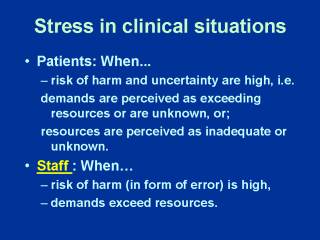| front |1 |2 |3 |4 |5 |6 |7 |8 |9 |10 |11 |12 |13 |review |
 |
There are no
differences between the circumstances causing stress in patient and staff, such as
doctors. The situations which embody these circumstances may differ: for patients, they
are often situations in which there is a high degree of uncertainty. This is one of the
major reasons why as a doctor, you must always explore whether your patient has sufficient
information regarding their condition, treatment, side-effects and outcomes. Some will
want lots of information, others will prefer less. Treat every patient as unique. Other circumstances are important. A patient about to undergo an endoscopy, (or any other kind of procedure) for example, needs two kinds of information. Procedural information - what will be done, in what order. This is why you should explain, in many procedures, what you are going to do next (there are exceptions when you can avoid more stress by not telling, but as a general rule, telling is preferred). Sensation information - what it will feel like is often also helpful so that the patient knows that any discomfort in “normal” and not an indication of something going wrong (avoiding stimulus ambiguity). Both of these forms of information enable predictability. Predictability enables accurate estimations of coping demands and enables behavioural and psychological preparation to confront threat, facilitating the effectiveness of coping. For doctors and nurses, the demands are not usually threats to health, but demands for performance which tax or exceed the person’s abilities. Having to work 36 hours without sleep increases the risk of making an error. However, so do other aspects of medical work, such as hierarchical systems and task demands. There is a tendency for health workers to “deny” their vulnerability to these problems (view the BMJ link above). That knowledge alone is potentially harmful and reflects a marginal control situation. Marginal control situations (remember the Executive Monkey?) can cause a range of physiological alterations to cardiovascular, pressor, gastrointestinal, immunological and hormonal systems. If prolonged and sustained, these can strain homeostatic mechanisms and may even be pathogenic. When people face high threat associated with prolonged, marginally controllable demands with which they must cope, then they often successfully cope with the demands, but experience high levels of subjective distress, known as “stress”. When the demands are eventually removed, it is then that illness often occurs, not when the demands are being coped with. |